|
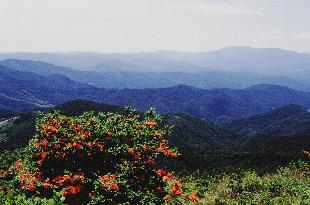 Probably the most beautiful place I have ever been is
a stretch of the Appalacian
Trail along the border of North Carolina and Tennessee near Roan Mountain
and some of the highest peaks in the eastern United States.
This section of the trail from Roan to Jane Bald and Grassy Ridge
winds along the ridges at an altitude from
5000 feet to over 6000 feet through mostly open meadow.
From the parking lot at Carver's Gap, the trail ascends approximately
1000 feet via log steps
to the summit of Round Bald, elevation 5826 feet.
Although it doesn't look very steep
from the parking area, half way up the incline it becomes very
clear that one is gaining significant altitude. There is no
need to rush the climb, though, because the slope is adorned with
beautiful rhododendrons and azaleas, and the views of Roan High
Bluff and the surrounding mountains are spectacular.
Scattered throughout the grassy meadow
are beautiful specimens of the
purple rhododendrons (R. catawbiense), a few flame azaleas (R. calendulaceum),
occasional blooms of the rare Gray's Lily (Lilium grayi), many other wild
flowers.
Probably the most beautiful place I have ever been is
a stretch of the Appalacian
Trail along the border of North Carolina and Tennessee near Roan Mountain
and some of the highest peaks in the eastern United States.
This section of the trail from Roan to Jane Bald and Grassy Ridge
winds along the ridges at an altitude from
5000 feet to over 6000 feet through mostly open meadow.
From the parking lot at Carver's Gap, the trail ascends approximately
1000 feet via log steps
to the summit of Round Bald, elevation 5826 feet.
Although it doesn't look very steep
from the parking area, half way up the incline it becomes very
clear that one is gaining significant altitude. There is no
need to rush the climb, though, because the slope is adorned with
beautiful rhododendrons and azaleas, and the views of Roan High
Bluff and the surrounding mountains are spectacular.
Scattered throughout the grassy meadow
are beautiful specimens of the
purple rhododendrons (R. catawbiense), a few flame azaleas (R. calendulaceum),
occasional blooms of the rare Gray's Lily (Lilium grayi), many other wild
flowers.
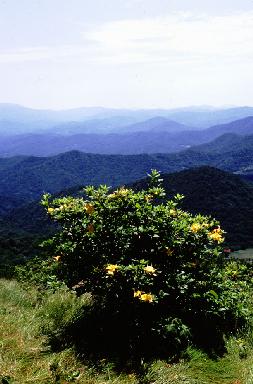 At the top of Round Bald, the view is
magnificent on a clear day. It
reminds me of the opening to the movie "Sound of Music", except I
don't remember Julie Andrews being surrounded by rhododendrons, azaleas,
and such rare wildflowers.
The Appalacian Trail in this area has been rerouted to help combat erosion,
and as it descends to the right towards
Engine Gap, the path winds through some spectacular displays of
Rhododendron calendulaceum.
One of my favorite plants there is a small yellow R. calendulaceum
poised on the ridge. It provides a perfect photographic opportunity for
anyone with a camera, and those of you who have traveled that path
will surely recognize this plant in its setting.
At the top of Round Bald, the view is
magnificent on a clear day. It
reminds me of the opening to the movie "Sound of Music", except I
don't remember Julie Andrews being surrounded by rhododendrons, azaleas,
and such rare wildflowers.
The Appalacian Trail in this area has been rerouted to help combat erosion,
and as it descends to the right towards
Engine Gap, the path winds through some spectacular displays of
Rhododendron calendulaceum.
One of my favorite plants there is a small yellow R. calendulaceum
poised on the ridge. It provides a perfect photographic opportunity for
anyone with a camera, and those of you who have traveled that path
will surely recognize this plant in its setting.
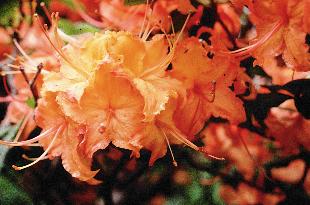 The trail continues on to Jane Bald, and more fine forms of R. calendulaceum.
Over the bank near the summit of Jane Bald
is another favorite plant, a brilliant orange and gold azalea
we call "Molten Lava". The flowers of this clone are magnificently frilled
and ruffled, measuring nearly two inches across.
Unfortunately, the secondary growth of blackberries, vaccinium and alder
in this area seems to be engulfing the falme azaleas as well as Gray's Lily.
On each trip, we usually try to trample a path to our favorite plants and break
back alder branches and blackberry stalks to give the azaleas and wildflowers
another year of growth before they get overrun. We usually notice that
others have already been there before we arrived, trying to assist
these rare and endangered wildflowers.
The trail continues on to Jane Bald, and more fine forms of R. calendulaceum.
Over the bank near the summit of Jane Bald
is another favorite plant, a brilliant orange and gold azalea
we call "Molten Lava". The flowers of this clone are magnificently frilled
and ruffled, measuring nearly two inches across.
Unfortunately, the secondary growth of blackberries, vaccinium and alder
in this area seems to be engulfing the falme azaleas as well as Gray's Lily.
On each trip, we usually try to trample a path to our favorite plants and break
back alder branches and blackberry stalks to give the azaleas and wildflowers
another year of growth before they get overrun. We usually notice that
others have already been there before we arrived, trying to assist
these rare and endangered wildflowers.
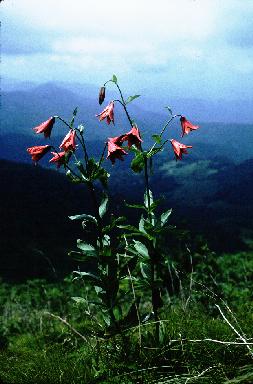 I have been concerned as to whether one should document these plants or
try to keep them secret, because there are ruthless collectors who will
raid and steal fine things. It was at Jane Bald that someone dug up this
beautiful clump of Gray's Lily pictured to
the right. One of the bulbs disappeared after 1995, the other by
June of 1997. I have decided that it is probably better to raise awareness of
theft of plants from the wild as a way to reduce those random acts that
threaten the natural beauty that so many others enjoy. Whover took this plant
did not dig up some insignificant red flower that would never be missed,
but took a friend that many of us knew and loved. Unfortunately, there is
another threat that could prove even worse
than an admiring public, and that is the continuing
explosion of the deer population.
During my annual trek in of June 2000, I saw considerable deer browsing on the
azaleas and rhododendrons.
In many places, all foliage and most young plants under five feet had been
completely defoliated. The buds on Gray's Lily had been eaten before they
even had a chance to open which not only ruined the chance to
appreciate the beauty of this endangered species, but
also its chance to
to reproduce by seed.
Having seen what devastation this overpopulation has done to biological
diversity in parts of Virginia, including my own farm in Amherst County,
the potential for destruction in the next decade worries me greatly.
If only we could train deer to eat the encroaching vegetation rather
than the rare plants, we could use them to our advantage.
I have been concerned as to whether one should document these plants or
try to keep them secret, because there are ruthless collectors who will
raid and steal fine things. It was at Jane Bald that someone dug up this
beautiful clump of Gray's Lily pictured to
the right. One of the bulbs disappeared after 1995, the other by
June of 1997. I have decided that it is probably better to raise awareness of
theft of plants from the wild as a way to reduce those random acts that
threaten the natural beauty that so many others enjoy. Whover took this plant
did not dig up some insignificant red flower that would never be missed,
but took a friend that many of us knew and loved. Unfortunately, there is
another threat that could prove even worse
than an admiring public, and that is the continuing
explosion of the deer population.
During my annual trek in of June 2000, I saw considerable deer browsing on the
azaleas and rhododendrons.
In many places, all foliage and most young plants under five feet had been
completely defoliated. The buds on Gray's Lily had been eaten before they
even had a chance to open which not only ruined the chance to
appreciate the beauty of this endangered species, but
also its chance to
to reproduce by seed.
Having seen what devastation this overpopulation has done to biological
diversity in parts of Virginia, including my own farm in Amherst County,
the potential for destruction in the next decade worries me greatly.
If only we could train deer to eat the encroaching vegetation rather
than the rare plants, we could use them to our advantage.
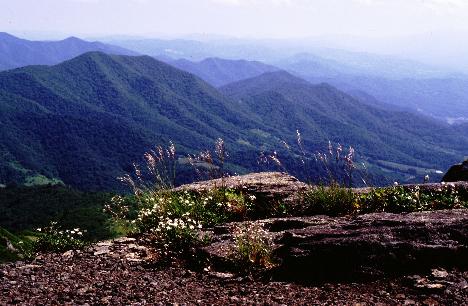 Beyond Jane Bald, the Appalacian Trail bears to the left, but we usually
take a side trip out to Grassy Ridge so we can admire the views from
its 6189 foot open summit. Masses of R. catawbiense
cover the mountain tops in that area, but it wasn't until June of 2001
that I had a chance to see Roan Highlands in
Peak Bloom. Prior to that time I had never seen that region
when the rhododendrons were at their peak.
On each trip I seemed to just miss the
grand show for some reason or another. One
time, the flowers seemed to be at peak condition but the fog was so
thick that it was
difficult to see more than 30 feet. Vistas of the mountains were
completely obscured. Another time, a cool spring
had delayed blooming so everything was in tight bud when I got there.
I made the nine hour drive from my home back to the Roan Highlands a few
weeks later, only to find that a hail storm had ripped the blossoms
from their trusses the day before. In mid June of 2000, I was
certain that I was on schedule. As I ascended the mountain, though,
I realized that something was wrong. Apparently, when my garden in
northern Virginia was experiencing a refreshing cool spell several
weeks before, the eastern mountain tops at an elevation of
6000 feet had suffered a killing frost, damaging the flower buds
just as they were
expanding.
Beyond Jane Bald, the Appalacian Trail bears to the left, but we usually
take a side trip out to Grassy Ridge so we can admire the views from
its 6189 foot open summit. Masses of R. catawbiense
cover the mountain tops in that area, but it wasn't until June of 2001
that I had a chance to see Roan Highlands in
Peak Bloom. Prior to that time I had never seen that region
when the rhododendrons were at their peak.
On each trip I seemed to just miss the
grand show for some reason or another. One
time, the flowers seemed to be at peak condition but the fog was so
thick that it was
difficult to see more than 30 feet. Vistas of the mountains were
completely obscured. Another time, a cool spring
had delayed blooming so everything was in tight bud when I got there.
I made the nine hour drive from my home back to the Roan Highlands a few
weeks later, only to find that a hail storm had ripped the blossoms
from their trusses the day before. In mid June of 2000, I was
certain that I was on schedule. As I ascended the mountain, though,
I realized that something was wrong. Apparently, when my garden in
northern Virginia was experiencing a refreshing cool spell several
weeks before, the eastern mountain tops at an elevation of
6000 feet had suffered a killing frost, damaging the flower buds
just as they were
expanding.
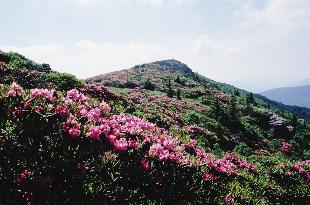
Fortunately, the beauty of the Roan Highlands is under the watchful eye
of various conservation groups, so it is not likely that
uncontrolled development will desecrate
the landscape. Now if we can keep eliminate destruction of the fine
details brought on by inconsiderate people and hungry deer, this
magificent scenery can continue to be one of the finest examples
of nature's perfection.
|